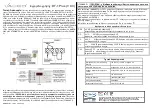
Enhanced Universal Serial Communication Interface B (eUSCI_B) Overview
958
SLAU356I – March 2015 – Revised June 2019
Copyright © 2015–2019, Texas Instruments Incorporated
Enhanced Universal Serial Communication Interface (eUSCI) – I
2
C Mode
26.1 Enhanced Universal Serial Communication Interface B (eUSCI_B) Overview
The eUSCI_B module supports two serial communication modes:
•
I
2
C mode
•
SPI mode
If more than one eUSCI_B module is implemented on one device, those modules are named with
incrementing numbers. For example, if one device has two eUSCI_B modules, they are named eUSCI0_B
and eUSCI1_B.
26.2 eUSCI_B Introduction – I
2
C Mode
In I
2
C mode, the eUSCI_B module provides an interface between the device and I
2
C-compatible devices
connected by the two-wire I
2
C serial bus. External components attached to the I
2
C bus serially transmit or
receive serial data to or from the eUSCI_B module through the 2-wire I
2
C interface.
The eUSCI_B I
2
C mode features include:
•
7-bit and 10-bit device addressing modes
•
General call
•
START, RESTART, and STOP
•
Multi-master transmitter/receiver mode
•
Slave receiver/transmitter mode
•
Support for standard mode up to 100 kbps, fast mode up to 400 kbps, and fast mode plus up to
1 Mbps
•
Programmable UCxCLK frequency in master mode
•
Designed for low power
•
8-bit byte counter with interrupt capability and automatic STOP assertion
•
Up to four hardware slave addresses, each having its own interrupt and DMA trigger
•
Mask register for slave address and address received interrupt
•
Clock low time-out interrupt to avoid bus stalls
shows the eUSCI_B when configured in I
2
C mode.
















































